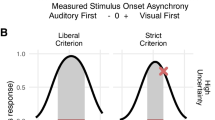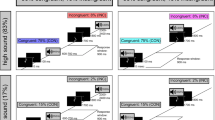Abstract
We continuously receive the external information from multiple sensors simultaneously. The brain must judge a source event of these sensory informations and integrate them. It is thought that judging the simultaneity of such multisensory stimuli is an important cue when we discriminate whether the stimuli are derived from one event or not. Although previous studies have investigated the correspondence between an auditory-visual (AV) simultaneity perceptions and the neural responses, there are still few studies of this. Electrophysiological studies have reported that ongoing oscillations in human cortex affect perception. Especially, the phase resetting of ongoing oscillations has been examined as it plays an important role in multisensory integration. The aim of this study was to investigate the relationship of phase resetting for the judgment of AV simultaneity judgement tasks. The subjects were successively presented with auditory and visual stimuli with intervals that were controlled as \(\mathrm{SOA_{50\%}}\) and they were asked to report whether they perceived them simultaneously or not. We investigated the effects of the phase of ongoing oscillations on simultaneity judgments with AV stimuli with SOAs in which the detection rate of asynchrony was 50 %. It was found that phase resetting at the beta frequency band in the brain area that related to the modality of the following stimulus occurred after preceding stimulus onset only when the subjects perceived AV stimuli as simultaneous. This result suggested that beta phase resetting occurred in areas that are related to the subsequent stimulus, supporting perception multisensory stimuli as simultaneous.






Similar content being viewed by others
References
Alho K, Woods DL, Algazi A, Knight RT, Naatanen R (1994) Lesions of frontal cortex diminish the auditory mismatch negativity. Electroencephalogr Clin Neurophysiol 91(5):353–362
Babiloni C, Vecchio F, Bultrini A, Luca Romani G, Rossini PM (2006) Pre- and poststimulus alpha rhythms are related to conscious visual perception: a high-resolution EEG study. Cereb Cortex 16(12):1690–1700
Benjamini Y, Hochberg Y (1995) Controlling the false discovery rate: a practical and powerful approach to multiple testing. J R Stat Soc 57(1):289–300
Busch NA, Dubois J, VanRullen R (2009) The phase of ongoing EEG oscillations predicts visual perception. J Neurosci 29(24):7869–7876
Bushara KO, Grafman J, Hallet M (2001) Neural correlates of auditory-visual stimulus onset asynchrony detection. J Neurosci 21(1):300–304
Dugue L, Marque P, VanRullen R (2011) The phase of ongoing oscillations mediates the causal relation between brain excitation and visual perception. J Neurosci 31(33):11889–11893
Franciotti R, Brancucci A, Della Penna S, Onofrj M, Tommasi L (2011) Neuromagnetic responses reveal the cortical timing of audiovisual synchrony. Neuroscience 193:182–192
Fries P (2005) A mechanism for cognitive dynamics: neuronal communication through neuronal coherence. Trends Cogn Sci 9(10):474–480
Fujisaki W, Shimojo S, Kashino M, Nishida S (2004) Recalibration of audiovisual simultaneity. Nat Neurosci 7(7):773–778
Haenschel C, Baldeweg T, Croft RJ, Whittington M, Gruzelier J (2000) Gamma and beta frequency oscillations in response to novel auditory stimuli: a comparison of human electroencephalogram (EEG) data with in vitro models. Proc Natl Acad Sci USA 97(13):7645–7650
Hanslmayr S, Aslan A, Staudigl T, Klimesch W, Herrmann CS, Bauml KH (2007) Prestimulus oscillations predict visual perception performance between and within subjects. NeuroImage 37(4):1465–1473
Kayser C, Petkov CI, Logothetis NK (2008) Visual modulation of neurons in auditory cortex. Cereb Cortex 18(7):1560–1574
Keil J, Muller N, Ihssen N, Weisz N (2012) On the variability of the McGurk effect: audiovisual integration depends on prestimulus brain states. Cereb Cortex 22(1):221–231
Lakatos P, Chen CM, O’Connell MN, Mills A, Schroeder CE (2007) Neuronal oscillations and multisensory interaction in primary auditory cortex. Neuron 53(2):279–292
Lakatos P, O’Connell MN, Barczak A, Mills A, JzVitt DC, Schroeder CE (2009) The leading sense: supramodal control of neurophysiological context by attention. Neuron 64(3):419–430
Le Van Quyen M, Bragin A (2007) Analysis of dynamic brain oscillations: methodological advances. Trends Neurosci 30(7):365–373
Mathewson KE, Gratton G, Fabiani M, Beck DM, Ro T (2009) To see or not to see: prestimulus alpha phase predicts visual awareness. J Neurosci 29(9):2725–2732
Naue N, Rach S, Struber D, Huster RJ, Zaehle T, Korner U, Herrmann CS (2011) Auditory event-related response in visual cortex modulates subsequent visual responses in humans. J Neurosci 31(21):7729–7736
Pascual-Marqui RD, Michel CM, Lehmann D (1994) Low resolution electromagnetic tomography: a new method for localizing electrical activity in the brain. Int J Psychophysiol 18(1):49–65
Romei V, Gross J, Thut G (2010) On the role of prestimulus alpha rhythms over occipito-parietal areas in visual input regulation: correlation or causation? J Neurosci 30(25):8692–9697
Sakowitz OW, Quian Quiroga R, Schurmann M, Basar E (2005) Spatio-temporal frequency characteristics of intersensory components in audiovisually evoked potentials. Cogn Brain Res 23(2–3):316–326
Schroeder C, Lakatos P, Kajikawa Y (2008) Neuronal oscillations and visual amplification of speech. Trends Cogn Sci 12(3):106–113
Senkowski D, Molholm S, Gomez-Ramirez M, Foxe JJ (2006) Oscillatory beta activity predicts response speed during a multisensory audiovisual reaction time task: a high-density electrical mapping study. Cereb Cortex 16(11):1556–1565
Senkowski D, Gomez-Ramirez M, Lakatos P, Wylie GR, Molholm S, Schroeder CE, Foxe JJ (2007) Multisensory processing and oscillatory activity: analyzing non-linear electrophysiological measures in humans and simians. Exp Brain Res 177(2):184–195
Senkowski D, Schneider TR, Foxe JJ, Engel AK (2008) Crossmodal binding through neural coherence: implications for multisensory processing. Trends Neurosci 31(8):401–409
Stone JV, Hunkin NM, Porrill J, Wood R, Keeler V, Beanland M, Port M, Porter NR (2001) When is now? Perception of simultaneity. Proc Biol Sci 268(1462):31–38
Thorne JD, De Vos M, Viola FC, Debener S (2011) Cross-modal phase reset predicts auditory task performance in humans. J Neurosci 31(10):3853–3861
Torrence C, Compo GP (1998) A practical guide to wavelet analysis. Bull Am Meteorol Soc 79(1):61–78
VanRullen R, Koch C (2003) Is perception discrete or continuous? Trends Cogn Sci 7(5):207–213
VanRullen R, Reddy L, Koch C (2006) The continuous wagon wheel illusion is associated with changes in electroencephalogram power at approximately 13 Hz. J Neurosci 26(2):502–507
Vroomen J, Keetels M (2010) Perception of intersensory synchrony: a tutorial review. Atten Percept Psychophys 72(4):871–884
Woods D (1995) The component structure of the N1 wave of the human auditory evoked potential. Electroencephalogr Clin Neurophysiol 44:102–109
Zampini M, Guest S, Shore DI, Spence C (2005) Audio-visual simultaneity judgments. Percept Psychophys 67(3):531–544
Author information
Authors and Affiliations
Corresponding author
Rights and permissions
About this article
Cite this article
Kambe, J., Kakimoto, Y. & Araki, O. Phase reset affects auditory-visual simultaneity judgment. Cogn Neurodyn 9, 487–493 (2015). https://doi.org/10.1007/s11571-015-9342-4
Received:
Revised:
Accepted:
Published:
Issue Date:
DOI: https://doi.org/10.1007/s11571-015-9342-4




